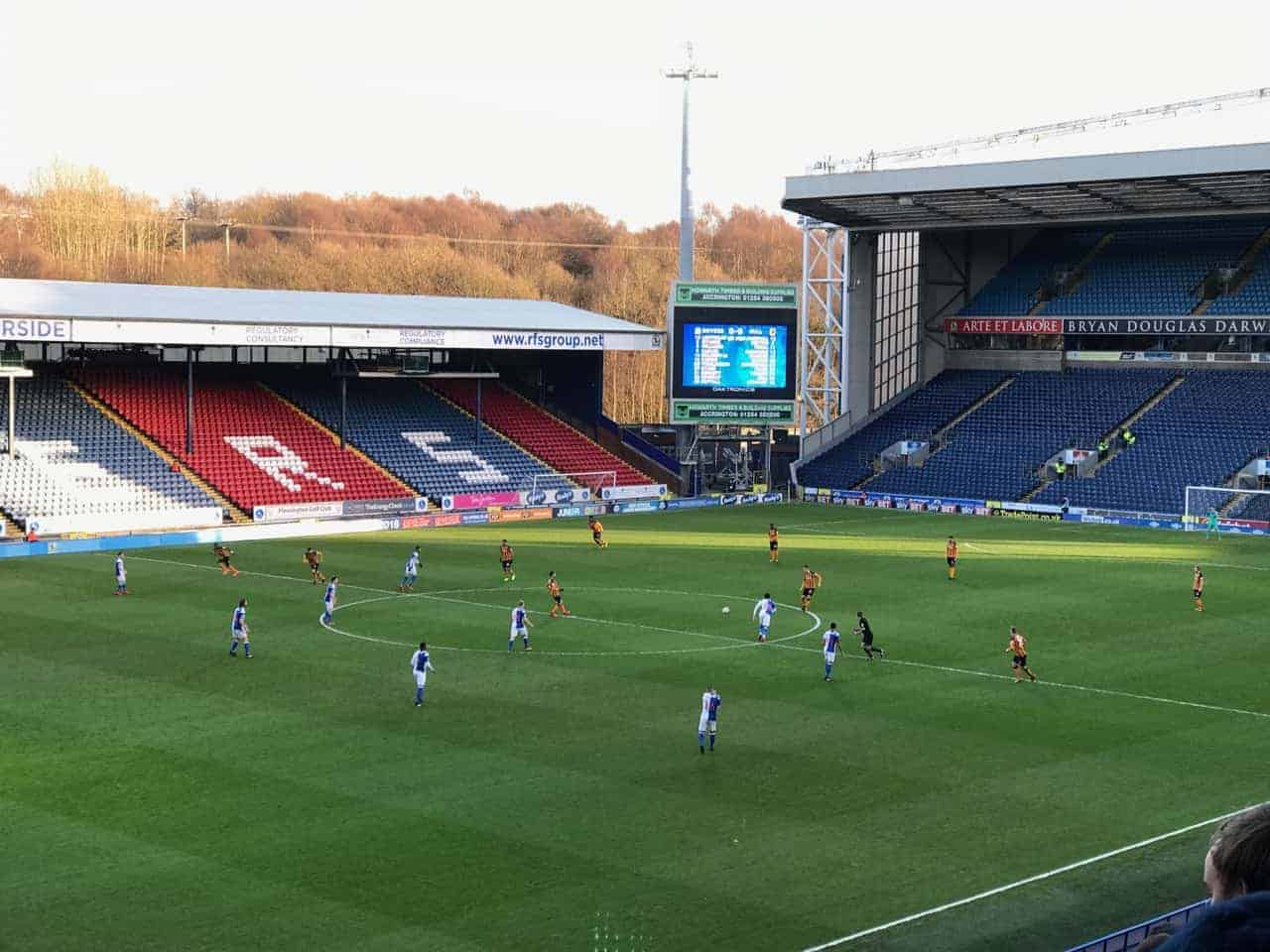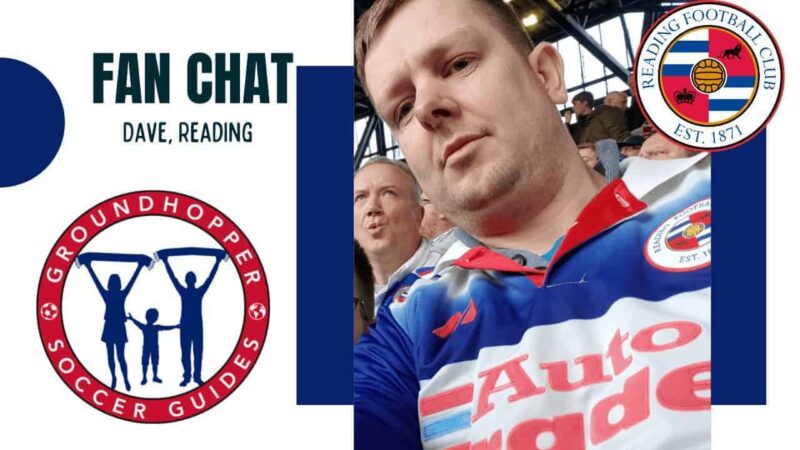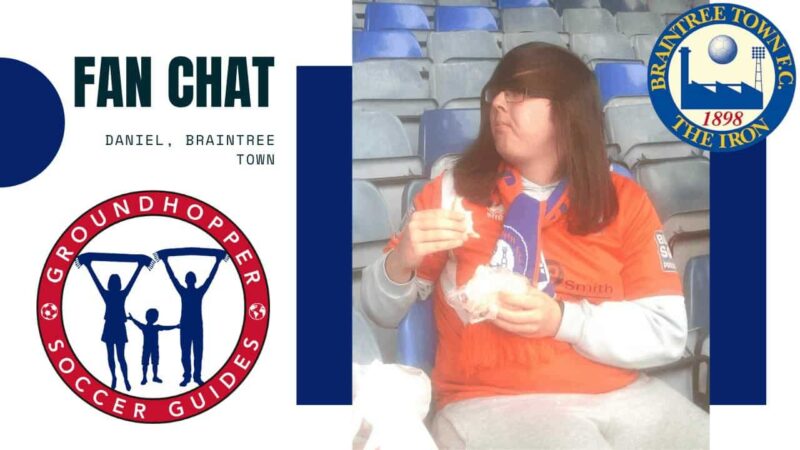“Fan Chats” is our series of videos in which we meet supporters of English football…
My Visit to Blackburn: Town and Football Club

(2023 Update: Blackburn Rovers were promoted to The Championship in 2018 and are still there for the 2023-24 season.)
Before I tell you about my day in Blackburn, and the game I saw at Blackburn Rovers FC, allow me to introduce you to the Standard Northern English Town Story.
I have seen this in every northern town I’ve visited, and you will as well, so we might as well get it out of the way.
Standard Northern English Town History:
- There was a forest with people living here and there.
- The Romans came through, and if the place was important, they built something. A smidgeon of said something remains around here somewhere.
- There was a monastery. Perhaps a bridge.
- There was a plague that killed pretty much everybody.
- The Dark Ages happened, and we don’t know shit about them.
- The town was mentioned in The Domesday Book, which no one has ever actually seen much less read, and it had a name kind of similar to what it’s called now.
- In medieval times, there were weavers/cobblers/carpenters/whatever working in their homes. There was trade, and the place was kind of important.
- There was something — wood, textiles, beer, pottery, something — for which the place was famous.
- There was a battle or something nearby during the Civil War.
- The Industrial Revolution happened, during which:
- Canals were dug
- Machines took over and enabled massive production
- There was resistance to machines
- The machines won
- Fortunes were made
- Parks and big homes and brick and stone buildings were built, and art was collected
- The town was important, and famous people were here, if briefly
- An entertainer whom old English people will have heard of grew up here.
- It was a polluted, miserable shithole for 98 percent of the poor, wretched people living here
- The Industrial Revolution petered out because … competition, technological advances, karma, whatever.
- The wars came, and lots more people died. They were very brave, and there are monuments to them in town.
- The last of the industry died.
- The town almost died.
- Lots of people from South Asia started moving here.
- Now it’s coming back as, well, tourism? Hipsterism? Art colony? Resort area? Something like that.
- Or it’s not really coming back.
- They pedestrianized part of the downtown area.
- There is a large rejuvenation project going on.
- There’s a Christmas festival.
- The local football club won the FA Cup in about 1923.
- They kind of suck now, but we still love them.
… and …. say hello to Blackburn, Lancashire!
(If that sounds familiar, it’s because of the 4,000 holes the Beatles sang about.)
Blackburn is the kind of town — and I see this all the time, as well — where if you look on TripAdvisor for the Top 10 Things to Do, you see a park, a museum, a “living farm,” another park, a historic home with gardens, an art gallery, a shopping mall, and probably another park.
But I have been to enough of these places that I have learned three things about all of them: they are quiet and pleasant, they are filled with wonderful people, and to find out what’s really going on in town, you just have to get off the train and walk around.
Also, if you want to start a conversation with anyone — especially dudes — at least read the history of the football club on your train to town.
Walking Around Blackburn
And so I did. I also had read, while coming up on the train from Liverpool, that Blackburn has a particularly high percentage of South Asians — over 30 percent, in fact. More than one English person told me something like, “You should be able to get a good curry up there.” It’s a thing.
I got off the train, and to borrow the current expression, it was cold “af.” And windy. There appeared to be a cathedral and a statue of a woman — Queen Victoria, I reckoned — but right past that was a cafe that had warmth and coffee and baked things. I retreated there.
There, I finished my research and laid out a plan: Corporation Park, despite its name; Town Hall; cathedral; textile museum; Indian for lunch; walk past all the pubs between here and the ground; walk to the game; ask around for the best fish and chips; stay warm; split.
First, a few more images from my walkabout:
Seeing A Game at Blackburn Rovers FC
Rovers are the essence of a traditional football club.
I will write a whole “meet a new club” post about them, but the quick summary is they were founded in 1875, were founder members of the Football League in 1888, spent most of their time in the top flight, and were one of the teams in the newly founded Premier League in 1992.
They actually won the Premier League in 1995 — one of only seven teams to do so — with Kenny Dalglish as manager and Alan Shearer banging in goals. Both of them left, Rovers were relegated a few years later, and after bouncing up and down a bit, they found themselves down in League One for 2017-18, but they finished second and were back in The Championship for 2018-19. (And they’ve been there ever since.)
They have played at Ewood Park since 1890, though of course the stadium structure is nowhere near original. Today it holds 31,000+, and as an occasional listener to the Men in Blazers podcast, I was thrilled to find myself walking towards it on Tweed Street.
There is a river behind, a memorial garden outside it, and it has one of the very few statues outside any stadium I’ve seen that is for neither a player nor a manager. Jack Taylor was a local steel man who made hundreds of millions of dollars and was their owner in the glory days. Just next to his statue was — at least on this day — the most chill, small-town-feeling FanZone I’ve ever seen.
It was around this time — and when I saw that the Riverside Stand wasn’t even open — that I started to realize I probably wasn’t going to see the Magic of the FA Cup. It was 3rd Round weekend, and the previous night I had been at a rocking Merseyside Derby, Liverpool vs Everton. Elsewhere around the country, great things were happening on this Saturday: upsets, great goals, roaring crowds. And then there were games like this one.
It was League One Rovers against struggling Hull City of the Championship. It was also cold and windy. I walked in to see the far stand completely empty, the one to my left sparsely populated at best, and at the other end the stand three-quarters closed with the rest holding what they claim was 858 Hull supporters. Maybe. I couldn’t see the rest of my stand well, but I guessed — correctly — that it looked about the same. Total official attendance for the day: 6,777.
It’s a bit sad, really, when they make local kids stand there on the touch lines and wave signs, while rock music blasts from the speakers and we all act like something exciting is about to happen — when really, it’s a Cup game that hardly anybody seems to care about. Include the players in that, for the first half was about as sleepy as it could be.
There was only occasional singing from the Hull folks, most of it making fun of the home fans, and no singing whatsoever from the home fans. I mean that literally, by the way. They. Did. Not. Sing. I think at one point a few lads in the end tried to start up “Tony Mowbray’s Barmy Army,” but, I mean … it’s cold.
It basically felt like showing up for a kids’ game at the school because you love them and they’re playing, but really, can we just avoid injuries, do your best, and get the hell out of here?
One story I have to share, though. In the picture to the right, you see three stewards wearing orange in the stands (you might have to click on the photo to expand it). Note that they are on the R, the E, and the S — in a completely closed stand! I guess there’s some regulation involved or something.
Well, before the game they were seated — curled up into little balls is more like it — on the V-E-R. Not quite next to each other, but in shouting distance. And then a guy from our side walked all the way around the pitch — I don’t know why I even noticed this — and made them spread out! It was quite possibly the most brilliant thing I’ve seen in more than 70 English football games. I wanted to go interview him and get his autograph after the game — and buy the poor stewards a Bovril each.
I decided to see if I could get the older fellow on my left to talk to me. Sometimes they’re not interested, especially when they hear an American accent and assume I’m a dipshit. (This happens a lot, I think.) Blackburn had a nice volley hit the crossbar, and I said to my neighbor — phrasing it Brit-style as best I could — “Nice volley, that.”
“Aye,” he said, “woulda been a cracker.”
So it begins.
The next thing I could think to comment on was that it would be nice to see Blackburn at least keep the ball after a throw-in, and before long, with no further distractions on the pitch, we fell into a lovely chat. He’s been coming for 60 years! When my MLS club, Portland Timbers, started in 1975, he already had 18 years under his belt at Ewood Park.
I asked him about the good old days, and he showed me where he was sitting when they won it. He asked me about MLS, and I told him about Timber Joey. Lots of people seem to know about Timber Joey, “the bloke with a chainsaw in the ground!” I pointed out a time when the keeper should have thrown it quicker, and he said they just don’t have it today. I asked how many changes they’d made, and he introduced me to the lineup. We talked a bit about tactics. He asked where else I’ve been, and we both agreed that Craven Cottage is worth a trip to London.
Oh, and Hull scored a scrappy header and won it, 1-0. Whatever. Rovers threw on some starters for the last bit and had some decent chances. The biggest cheer of the day was when the announcer told us Man City had come roaring back and beaten Burnley, 4-1. Among the million things an American would never know about English football: Blackburn Rovers and Burnley hate each other. It’s called the East Lancashire Derby.
I took a few pictures, chatted up a father and son who also agreed the boys didn’t have it today, then stood too long in the too cold and too windy air for a bus to the station. Changing trains at Preston, I caught up on the other scores and realized that, hey, sometimes you just pick the wrong ground to go to.
This guy saw it otherwise. I had to love his teenage enthusiasm, but … “the celebrations were absolutely mental”? I guess. (This, by the way, is an entire sub-genre of Youtube videos: the Away Game Vlog.)
I didn’t care, though. It’s another club off the list, I met a nice guy who told some good stories and showed an interest in my world, I had a terrific meal, and even came away with a few nearby places I want to check out next time.
Yes, there will be a next time. I need to see Rovers on a real day. I hope they get back to the Championship, at least. I’d like my neighbor to have some more stories to tell, and I’d like Blackburn, and Rovers, to have another shot at glory.







































































Post Comments